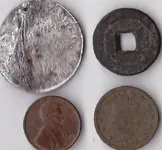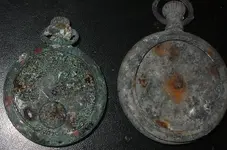Hello Jas,
I think that your token is from the 1904 St. Louis. Exposition. The purpose was to commemorate the 100th anniversary of the purchase of Louisiana.
HH,
Dave
LOUISIANA PURCHASE EXPOSITION 1904 ST. LOUIS, MO
Purpose: To commemorate 100th anniversary of Louisiana Purchase, "second in importance in nation's development only to American Revolution."
Site: About 1270 acres, parts of Forest Park and campus of Washington University. Of hundreds of structures, only portion of Art Palace was permanent; now serves as City Art Museum.
Attendance: Original opening set for April 30, 1903 but size and scope caused deferment. However, "Dedication Ceremonies" were held then, attended by President Roosevelt and Ex-President Taft. Finally opened April 30, 1904; closed Dec. 1, 1904. Attendance about 20,000,000; 13,000,000 paid.
Participants: On Aug. 20, 1901, President McKinley invited "all countries of the world to participate in this greatest of Expositions" which would "demonstrate America's progress since the Louisiana Purchase…promote friendly relations and the exchange of knowledge throughout the peoples of the world." All states and territories and "dozens" of foreign countries represented, scores erecting own buildings. Extensive Federal displays included Mint Exhibit.
Comment: Fifteen major exhibition Palaces radiated in fan pattern from central Festival Hall in "setting of lagoons, boulevards, gardens, fountains and sculpture" (1,200 pieces of statuary). Electric light, sign of progress then, used "lavishly" for both decoration and illumination. Featured were motor car, aeronautics and wireless telegraphy--all at their earliest, most exciting stage of development; spotlight on auto which had traveled from New York City to St. Louis, then "an unprecedented feat and a hazardous journey." Olympic Games held during Exposition in first concrete stadium built in U.S.
Medals: Official Souvenir medals below struck in Mint Exhibit on grounds; total of all medals "about 90,000." Silver was .600 fine; sold first for $1, later for $1.25. Yellow Bronze "tarnished quickly" so was replaced by plain Bronze; these, plus Gilt, sold for 25 cents each; in Gold-plate for 50 cents. Only one medal was struck in solid Gold (see The Numismatist, January 1911, p. 5). Charles S. Muir had the contract to sell official medals. In addition to the official medals, Exposition was prolific issuer of private medals of all kinds.







